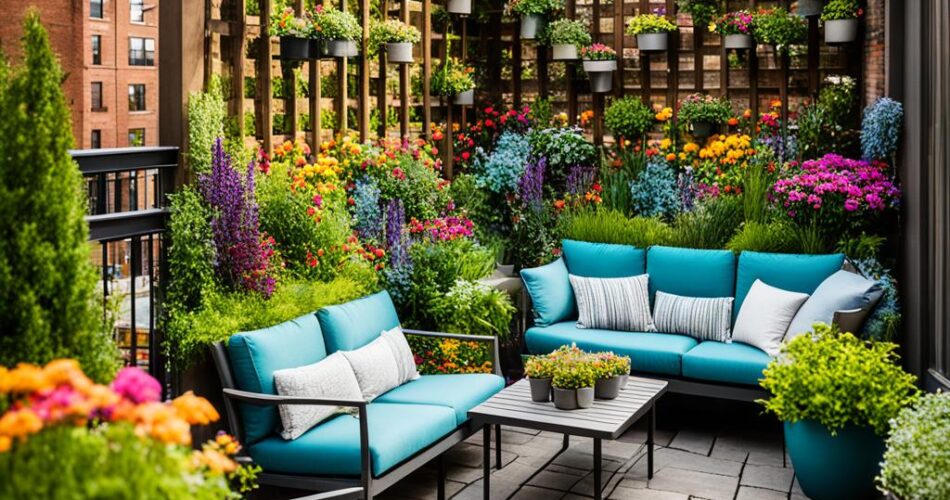Urban living often limits outdoor space. But you can still enjoy a lush green oasis. Terrace gardens are changing city landscapes, offering fresh air in concrete jungles.
These small space gardens bring nature to your doorstep. They create vibrant outdoor living spaces. These spaces serve as personal retreats for city dwellers.
Urban gardening solutions fit all sizes. From cozy balconies to sprawling rooftops, creative ideas abound. These green spaces beautify homes and support local biodiversity.
Terrace gardens also promote sustainable living practices. They prove that you don’t need a large yard. Even small areas can host thriving gardens.
Blue Orange Property Management Services values these urban oases. They offer top-notch maintenance for residential complexes. Their expertise keeps terrace gardens flourishing year-round.
With the right approach, tiny balconies transform. They become magical gardens full of life. These spaces burst with color, bringing joy to urban homes.
Key Takeaways
- Terrace gardens offer green solutions for urban dwellers
- Small space gardening is possible on balconies and rooftops
- Urban gardening supports biodiversity and sustainable living
- Professional services can help maintain terrace gardens
- Creative ideas can transform limited spaces into lush retreats
- Terrace gardens serve as personal outdoor living spaces
Maximizing Small Spaces in Urban Terrace Gardens
Small terraces can become lush, functional gardens with smart techniques. Vertical gardening and space-saving hacks transform tiny spaces into green oases. Let’s explore creative strategies for small terrace gardening.
Vertical Gardening Solutions
Vertical gardening is crucial for small terrace gardens. Marcus Eyles from Dobbies recommends climbing plants and trellises for charm without sacrificing space. Wall-mounted planters and hanging baskets increase growing area significantly.
Multi-tiered plant stands can also boost your garden’s potential. These options help maximize limited space effectively.
- Install a living wall system
- Use pocket planters on fences or walls
- Grow vines on trellises or wire grids
- Hang plants from ceiling hooks or railings
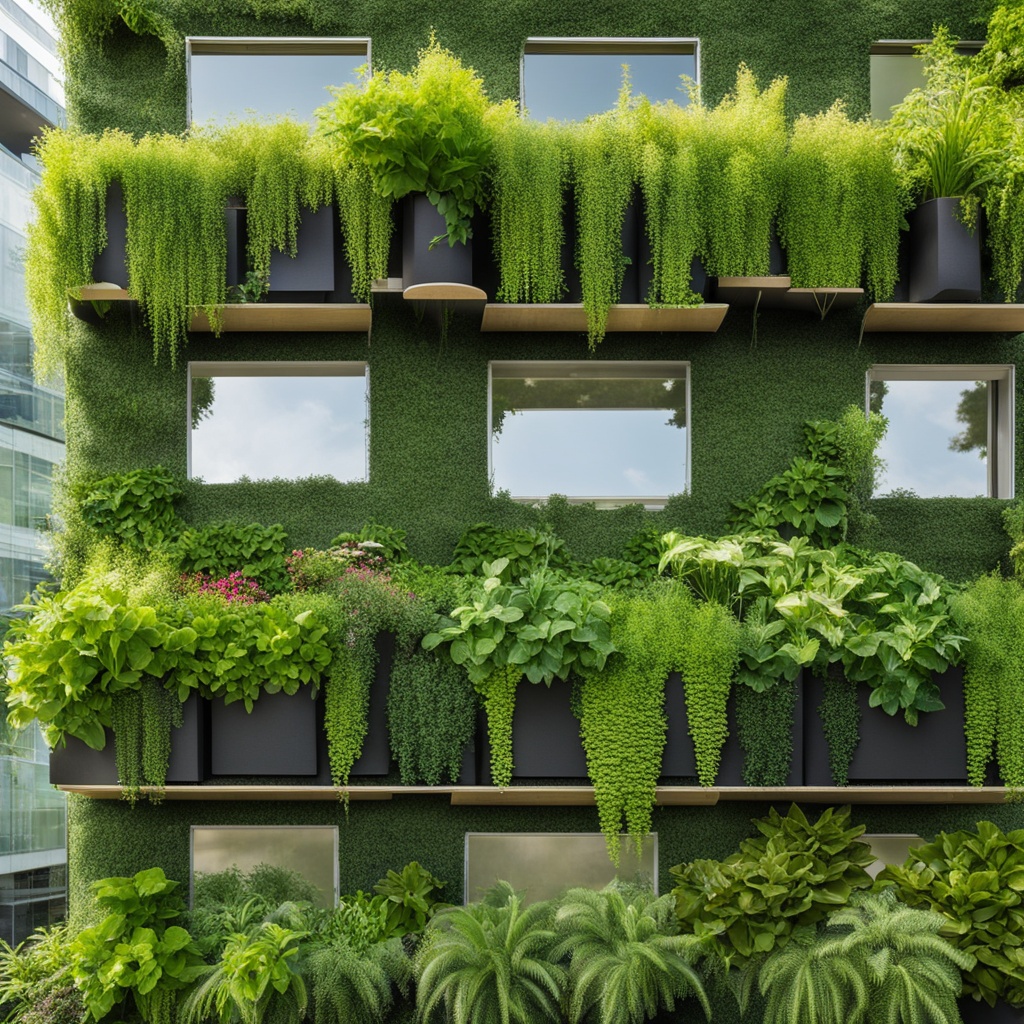
Multi-functional Furniture for Compact Areas
Francesca Hadland from Bridgman suggests flexible furniture for small outdoor spaces. Choose pieces that serve multiple purposes to maximize your terrace’s potential:
- Stackable chairs for easy storage
- Folding tables that can be tucked away
- Storage benches that offer seating and organization
- Bar stools that double as plant stands
Clever Storage Ideas for Garden Tools
Keeping your terrace tidy is vital in small spaces. Try these storage solutions to organize garden tools:
| Storage Solution | Benefits |
|---|---|
| Wall-mounted tool rack | Saves floor space, keeps tools accessible |
| Repurposed shoe organizer | Perfect for small hand tools and seed packets |
| Under-bench storage boxes | Utilizes unused space, protects tools from elements |
| Magnetic knife strip | Holds metal tools securely on walls |
These techniques can create a thriving garden in the smallest urban terrace. Vertical gardening, space-saving hacks, and clever container ideas are key.
Chris Bonnet from Gardening Express stresses careful planning for small terrace gardens. With thoughtful design, even tiny spaces can become beautiful, functional gardens.
Choosing the Right Plants for Your Terrace Garden
The right plants can turn your terrace into a lush oasis. Let’s explore some great options for your terrace garden containers.
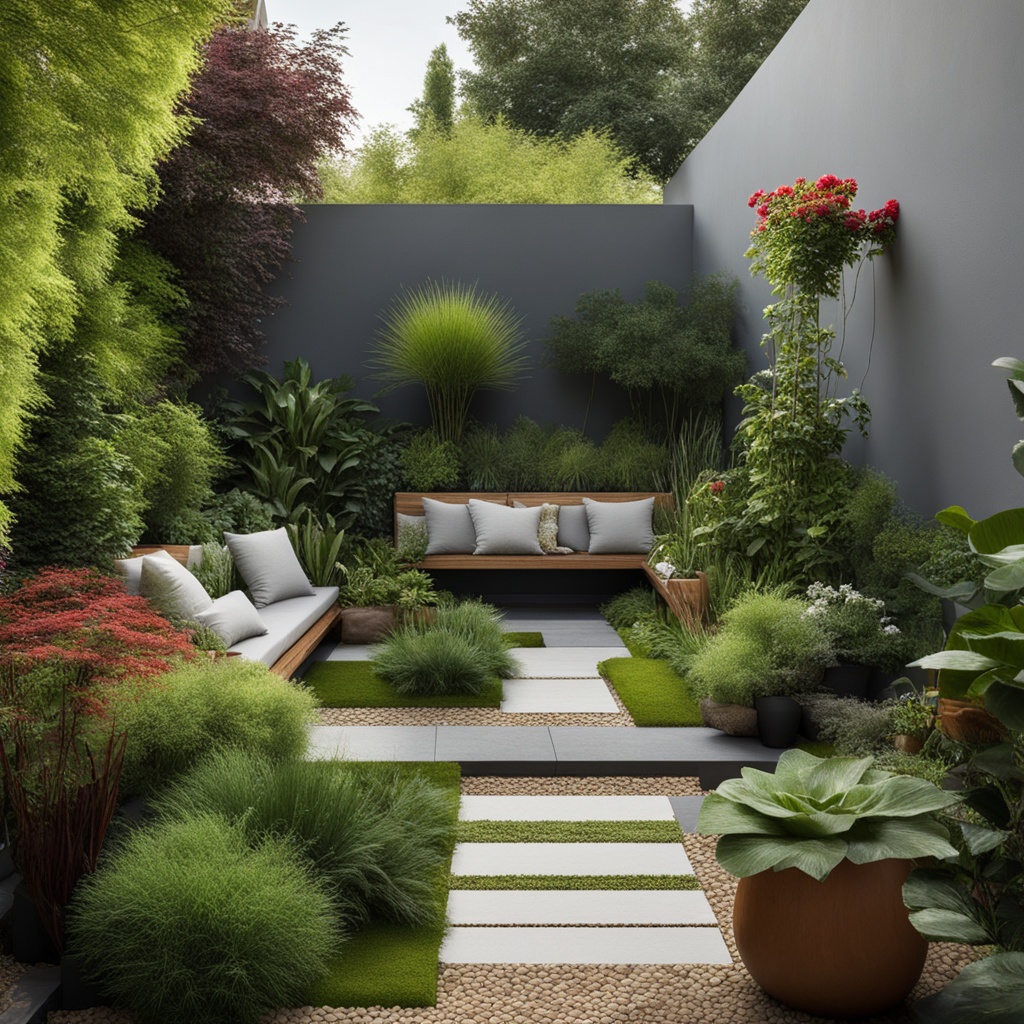
Low-maintenance plants are perfect for busy city dwellers. Evergreens like Aucuba Japonica can survive very cold temperatures. Yucca and cherry laurel are also great choices for outdoor spaces.
Add color and scent with these options:
- Geraniums: Perfect for balconies with their cascading growth
- Lavender: Adds a lovely scent and purple hues
- Jasmine: Offers a romantic aroma and delicate flowers
- Oleander: Provides vibrant blooms throughout summer
Drought-resistant plants are ideal for terrace gardens. Succulents and cacti need little care and add unique textures. They’re forgiving for new gardeners and thrive in dry conditions.
For edible gardens, try growing herbs and small veggies. Here are some great choices:
- Rosemary and thyme: Aromatic and versatile in cooking
- Cherry tomatoes: Compact and prolific producers
- Bush string beans: Low-maintenance and nitrogen-fixing
- Strawberries: Perfect for hanging baskets
Add perennial plants like hydrangeas or forsythia for year-round interest. They offer bursts of color in different seasons. Mix in seasonal flowers for a dynamic, ever-changing garden.
Consider your local climate when picking plants. Citrus trees can thrive in warmer regions. Dwarf conifers are great for cooler areas, offering evergreen charm.
Combine various plant types to create a diverse, thriving garden. Your terrace will become a joyful space all year round.
Innovative Terrace Garden Ideas for Urban Dwellers
City life doesn’t mean giving up on gardening. Urban dwellers can turn terraces into green havens with creative ideas. Let’s explore some innovative approaches for terrace gardens in the city.
Container Gardening for Versatility
Container gardening offers flexibility in urban spaces. Use various pots, barrels, or buckets to create a diverse terrace garden. This method allows for easy rearrangement as needs change.
- Choose lightweight planters for older buildings with weight limits
- Mix different pot sizes and heights to optimize space
- Repurpose items like plastic bottles for eco-friendly planters
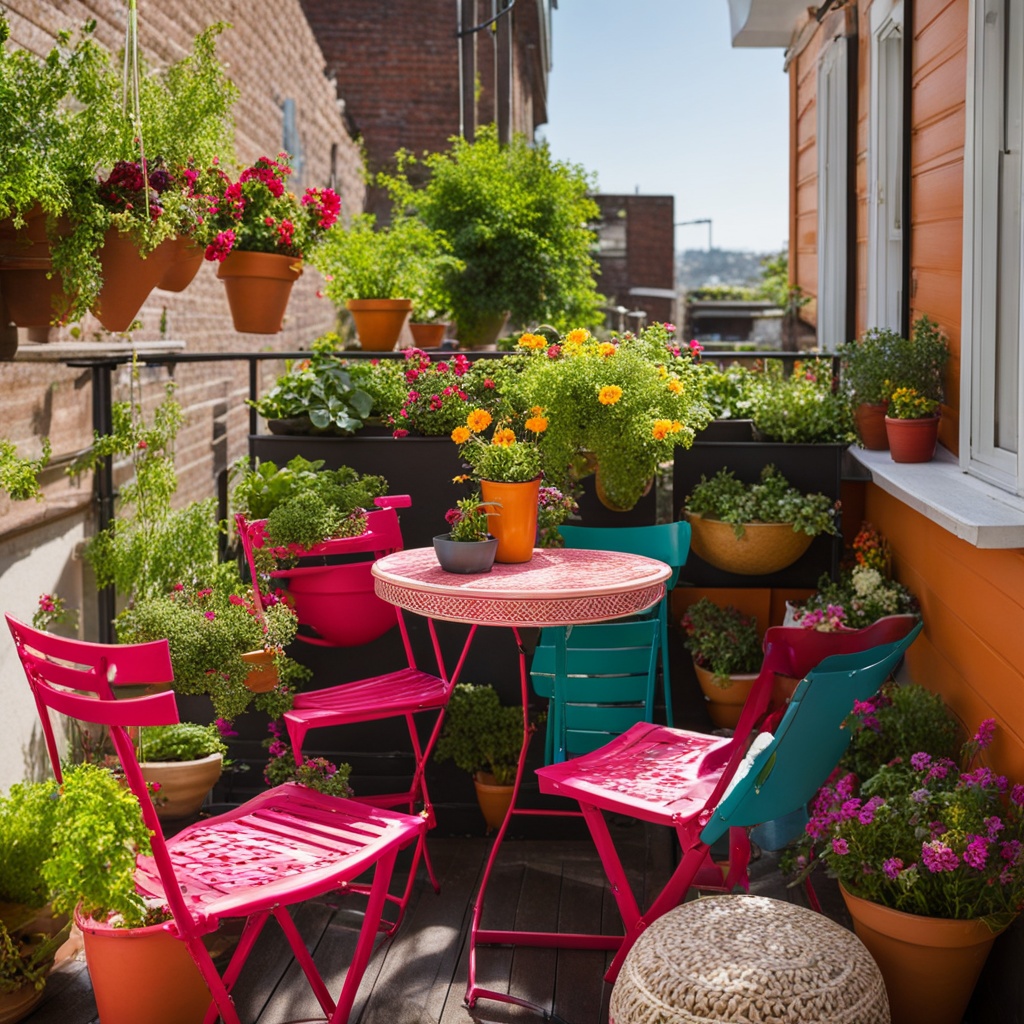
Hanging Gardens and Suspended Planters
Maximize terrace space with hanging gardens and suspended planters. These vertical solutions add depth to your urban oasis. They create interest without taking up floor space.
- Install rain gutter gardens for a cost-effective, portable option
- Use hanging shoe organizers for small herb gardens
- Incorporate window boxes to add greenery without taking up floor space
Edible Landscaping in Limited Spaces
Urban farming on your terrace can yield fresh produce. Edible landscaping combines beauty with functionality in small areas. It’s a great way to grow your own food.
| Plant Type | Best Options for Terraces |
|---|---|
| Vegetables | Tomatoes, cucumbers, okra, eggplants |
| Herbs | Thyme, rosemary, sage, lavender |
| Fruit Trees | Dwarf varieties, bonsai fruit trees |
Consider sun exposure and wind protection when planning your terrace garden. These factors play a crucial role in plant health. With innovative ideas, you can create a thriving green space in the city.
“Urban dwellers with roof terraces should be cautious about the load-bearing capacity due to the weight of plants and soil.” – Todd Haiman, New York City landscape designer
Sustainable Practices in Terrace Gardening
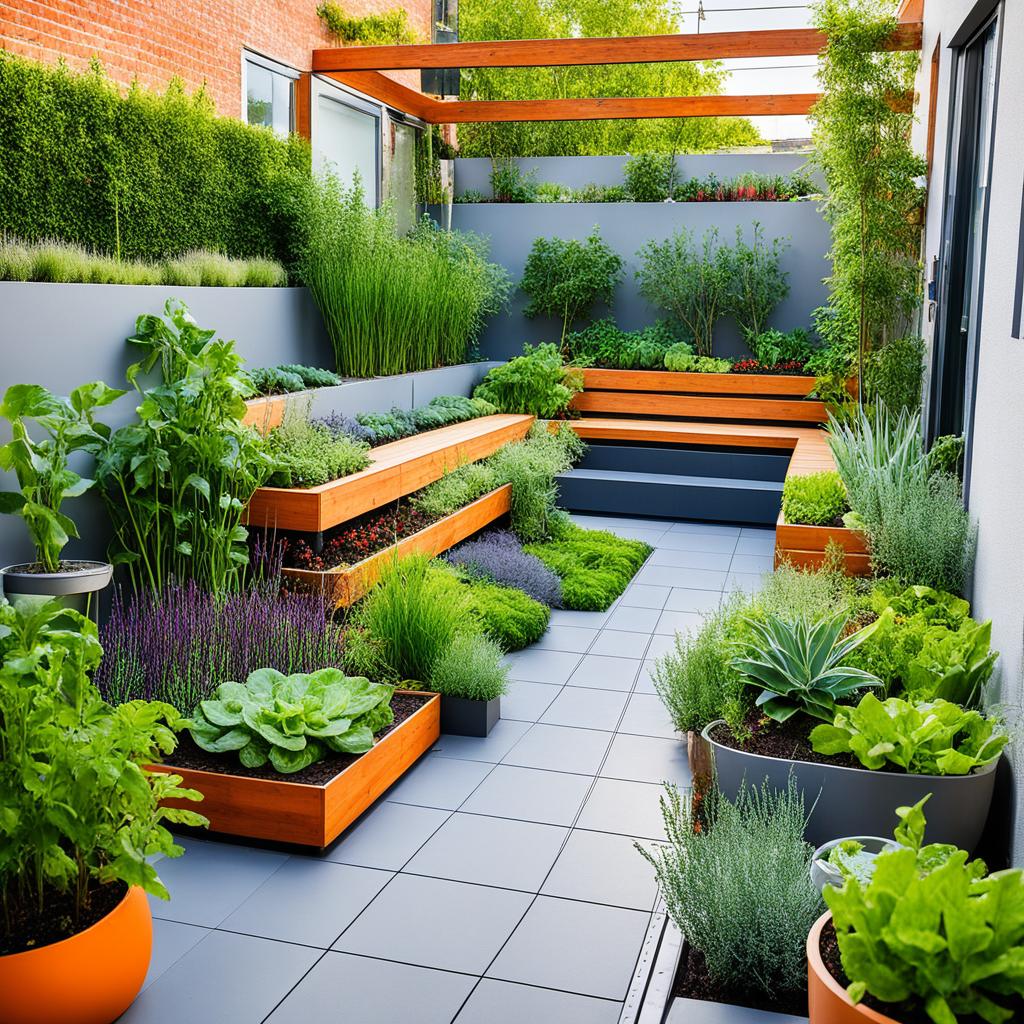
Sustainable terrace gardening turns city spaces into green havens. These gardens benefit the environment and people’s well-being. City dwellers can create thriving gardens using eco-friendly methods.
Organic gardening is key to sustainable terrace gardens. It avoids harmful chemicals and creates a healthier ecosystem. Composting kitchen scraps makes nutrient-rich soil, reducing the need for store-bought fertilizers.
Rainwater harvesting is crucial for sustainable terrace gardens. A simple system can collect 60 gallons from 1 inch of rain. This free water is ideal for plants, especially during dry periods.
- Install rain barrels to collect and store rainwater
- Use drip irrigation systems to minimize water waste
- Mulch plant beds to retain moisture and reduce evaporation
Native plants are vital for sustainable terrace gardening. They need less water and care than non-native species. These plants also support local wildlife and boost urban biodiversity.
“Native plants have deep-root systems that help in water conservation, which is crucial for sustainable landscaping, particularly in dry climates.”
Eco-friendly materials are important in sustainable terrace design. Old wooden crates can become planters or furniture. Permeable hardscapes let water soak into the ground, reducing runoff.
Urban gardeners can create beautiful, low-maintenance terrace gardens with these practices. These spaces provide fresh produce and natural beauty. They also help fight climate change in cities.
Creating a Relaxing Atmosphere in Your Terrace Garden
Smart design can turn your terrace into a peaceful retreat. An outdoor oasis offers the perfect spot to unwind after a long day.
Incorporating Water Features
Water features add a soothing touch to terrace gardens. A small fountain or cascading water wall can create a tranquil atmosphere. These elements help mask urban noise, enhancing the peaceful vibe.
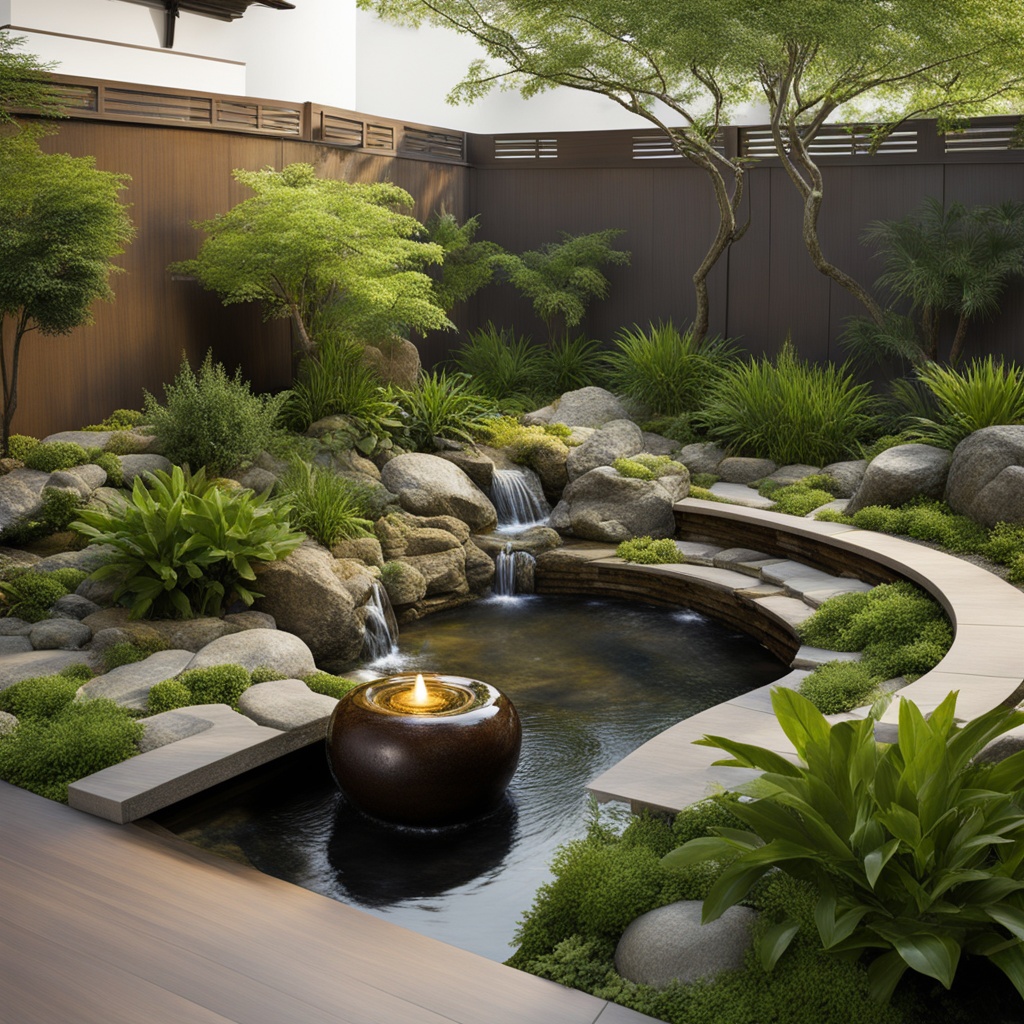
Lighting Design for Evening Ambiance
Thoughtful lighting transforms your terrace garden at night. Solar lanterns, string lights, or LED strips create a magical evening atmosphere. Uplighting plants or features adds depth to your outdoor space.
- Hang string lights across the terrace for a starry effect
- Place solar lanterns along pathways for safety and ambiance
- Use LED strip lights under seating or planters for a soft glow
Cozy Seating Arrangements for Outdoor Living
Comfort is key in creating inviting patio garden layouts. Choose weather-resistant furniture that encourages relaxation. Plush cushions, outdoor rugs, and throw pillows add warmth to your terrace garden.
| Seating Type | Best For | Features |
|---|---|---|
| Lounge Chairs | Sunbathing, Reading | Reclining, Cushioned |
| Hammocks | Napping, Stargazing | Portable, Space-saving |
| Outdoor Sofas | Entertaining, Lounging | Modular, Weather-resistant |
Consider the flow between different zones in your terrace garden. Create distinct areas for dining, lounging, and gardening. Use various materials and textures to define spaces and add visual interest.
“A well-designed terrace garden is an extension of your home, offering a peaceful retreat and a connection to nature in urban environments.”
Focus on these elements to create a relaxing outdoor sanctuary. Your terrace garden can become a perfect spot to enjoy nature and escape city life.
DIY Terrace Garden Projects for Urban Spaces
Urban dwellers can create lush retreats with creative DIY terrace gardens. These projects beautify spaces and provide a rewarding hobby. Let’s explore exciting ideas for your urban oasis.

Vertical gardening is a popular space-saving technique for terrace gardens. It allows you to grow various plants in limited areas. Create an herb wall using repurposed pallets or install vertical planters.
Upcycled garden accessories personalize your terrace garden. Transform old tin cans into charming planters or use wooden crates as raised beds. These solutions add character while being eco-friendly.
- Paint terracotta pots in vibrant colors for a cohesive look
- Build a mini greenhouse for year-round growing
- Construct a small bird feeder to attract wildlife
- Create a hanging gutter garden for a portable solution
A hanging gutter garden offers a clever solution for limited floor space. Mount gutters to your terrace walls and fill them with soil and plants. It’s great for growing herbs or trailing flowers without using floor area.
“DIY terrace gardens allow urban dwellers to reconnect with nature and express their creativity in small spaces.”
Consider the cost-effectiveness of DIY terrace garden projects. Professional retaining wall installation can cost $3,500 to $9,400. DIY terracing materials range from $4 to $20 per square foot, offering significant savings.
Tailor your terrace garden projects to your specific space and needs. With creativity and effort, you can create a thriving green sanctuary in your urban home.
Seasonal Care and Maintenance Tips for Terrace Gardens
Terrace garden upkeep varies with the seasons. Different urban gardening methods are needed throughout the year. Let’s explore tips to keep your terrace garden thriving all year.
Spring Planting and Preparation
Spring kicks off the growing season for terrace gardens. It’s time to prep your garden beds and start planting.
- Remove winter mulch and debris
- Prune dead branches from perennials
- Add fresh compost to garden beds
- Plant spring vegetables and flowers

Did you know that 74% of urban terrace gardens use container plants? They’re great for easy care and space-saving in small areas.
Summer Watering and Heat Management
Summer brings heat and increased watering needs. Here are tips to keep your terrace garden healthy:
- Water deeply in the morning or evening
- Use mulch to retain moisture
- Install a drip irrigation system
- Provide shade for heat-sensitive plants
Proper watering is vital for terrace gardens. It’s a key tip to remember during hot summer months.
Fall Cleanup and Winter Protection
As it gets colder, prepare your terrace garden for winter:
- Remove annual plants and harvest remaining vegetables
- Cut back perennials and add winter mulch
- Move sensitive plants indoors or to protected areas
- Clean and store garden tools
Waterproofing your terrace is crucial before winter. It prevents damage to the building and extends your garden’s life.
| Season | Key Maintenance Tasks | Urban Gardening Techniques |
|---|---|---|
| Spring | Planting, pruning, bed preparation | Container gardening, vertical planting |
| Summer | Watering, pest control, harvesting | Drip irrigation, companion planting |
| Fall | Cleanup, mulching, plant protection | Composting, cold frames |
| Winter | Planning, indoor seedling start | Indoor herb gardens, winter sowing |
Follow these seasonal tips to help your terrace garden thrive. Regular care is key to a beautiful and productive urban oasis.
Incorporating Technology in Modern Terrace Gardens
Smart gardening has transformed urban terrace gardens. Automated irrigation systems and garden apps make maintaining lush green spaces effortless. These tools have simplified garden care for city dwellers.

Automated irrigation systems are perfect for busy gardeners. They offer water-efficient technology with timers and smartphone control. You can set up watering schedules based on plant needs and adjust them remotely.
Garden apps have become essential for modern gardeners. Apps like Garden Pro suggest plants based on your garden’s conditions. They provide growing tips and pest alerts, helping you cultivate a thriving terrace garden.
- Plant Net: Helps identify plants through image analysis
- Smart Plant Home: Sends care notifications and organizes tasks
- Rescape AI: Enables AI-powered garden design starting at $7.49
AI garden design tools are changing how we plan terrace gardens. These apps let users experiment with different elements and themes. They create custom designs for any space, turning small urban areas into peaceful retreats.
| Technology | Benefit |
|---|---|
| Self-watering pots | Assist with consistent watering |
| Seedling heat mats | Speed up seed germination |
| Smart greenhouses | Allow remote monitoring and control |
| Robotic mowers | Automate lawn trimming |
Smart gardening tech creates beautiful, low-maintenance terrace gardens. These tools make urban gardening accessible to everyone. From automated watering to AI design, success is within reach for all gardeners.
Designing Your Terrace Garden Layout for Optimal Use
A well-planned terrace garden can become a stunning urban retreat. Let’s explore garden design ideas to maximize your small space. These tips will help you create a functional and beautiful outdoor area.
Zoning Your Terrace for Different Activities
Divide your terrace into zones to boost functionality. This approach creates a versatile space for various needs and activities.
- Seating area for relaxation
- Dining space for outdoor meals
- Gardening zone for plants and vegetables
- Play area for children or pets
Creating Visual Interest with Focal Points
Add eye-catching elements to your terrace garden for depth and character. These focal points will draw attention and create intrigue in your outdoor space.
- A statement planter with vibrant flowers
- A small water feature or fountain
- An artistic sculpture or garden ornament
- A vertical garden wall
Balancing Aesthetics and Functionality
When designing your terrace garden, aim for both beauty and practicality. Consider these important factors:
| Aspect | Considerations |
|---|---|
| Sun Exposure | South-facing areas receive most sunlight, ideal for sun-loving plants |
| Wind Protection | Urban gardens are often sheltered, but consider windbreaks if needed |
| Plant Selection | Mix perennials (40% of designs) with seasonal plants (25% of layouts) |
| Vertical Space | Utilize vertical gardening (10% of plans) for maximizing growth area |
A thoughtfully planned terrace garden enhances urban living. It provides aesthetic pleasure and practical benefits. Your garden can help regulate indoor temperatures and reduce your carbon footprint.
Overcoming Common Challenges in Urban Terrace Gardening
Urban terrace gardening creates green spaces in cities. It brings joy but also presents unique challenges. Let’s explore solutions and tips for common container gardening issues.
Limited Sunlight
Urban terraces often lack sunlight due to surrounding buildings. Here are some ways to overcome this:
- Choose shade-tolerant plants like ferns, hostas, and impatiens
- Use reflective surfaces to maximize available light
- Rotate plants regularly to ensure even sun exposure
Wind Exposure
High-rise terraces can experience strong winds. Protect your garden with these methods:
- Installing windbreaks or screens
- Using heavier containers to prevent tipping
- Selecting wind-resistant plants like ornamental grasses and succulents
Weight Restrictions
Structural limitations can pose a challenge. Address this problem with these solutions:
- Using lightweight containers and soil mixes
- Opting for vertical gardening solutions to distribute weight
- Consulting with a structural engineer for large-scale projects
Drainage Issues
Proper drainage is crucial for container gardens. Solve this issue with these tips:
- Selecting pots with adequate drainage holes
- Using a well-draining soil mix
- Implementing a drip irrigation system for efficient watering
| Challenge | Solution |
|---|---|
| Limited Space | Vertical gardening, hanging planters |
| Urban Pollution | Choose resilient plant species, use air-purifying plants |
| Pest Management | Companion planting, natural pest control methods |
These solutions help you tackle common container gardening challenges. You can create a thriving green oasis in your urban space.
Every challenge offers a chance to learn and solve problems creatively. Your gardening journey will be full of exciting discoveries.
Conclusion: Embracing the Beauty of Urban Terrace Gardens
Urban terrace gardens are revolutionizing city living. These green spaces offer fresh air in concrete jungles. They transform ordinary rooftops into vibrant urban oases.
K Studio’s innovative designs showcase endless possibilities in urban landscaping. They blend natural elements with modern architecture. Their creations are both functional and aesthetically pleasing.
K Studio often includes eco-friendly features like rainwater harvesting. They also use recycled materials, highlighting the sustainability of city gardening.
Green terraces offer benefits beyond visual appeal. They help regulate indoor temperatures and reduce energy costs. These spaces also promote biodiversity and improve air quality.
Urban gardens provide a connection to nature for city dwellers. From vegetable patches to wildflower meadows, they boost well-being. These spaces offer a perfect blend of functionality and natural beauty.
Every space has the potential to become a thriving garden. Urban terrace gardens prove that nature can flourish in cities. They’re a creative solution to urban challenges.
